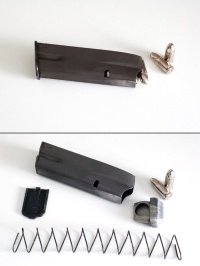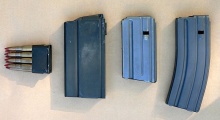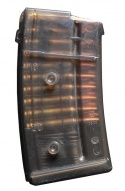Difference between revisions of "Magazine"
m (moved Magazine (firearm) to Magazine: Clarity: Most will be looking for the component, not the others.) |
m (1 revision) |
Latest revision as of 15:52, 15 March 2013


- This article deals with the firearm component. For periodical publications, see category:magazines; for the large-scale ammo storage facility, see Magazine (artillery).
A magazine is an ammunition storage and feeding device within or attached to a firearm. Magazines may be integral to the firearm (fixed) or removable (detachable). Clip is an incorrect term that is often used in place of magazine. Clips are used to feed magazines while magazines load cartridges into a firearm chamber.[1]
The cartridges in the magazine are loaded into the firearm either automatically or manually depending on the type of gun. Most often, the cartridge is brought into loading position by spring pressure. Some magazines are in turn loaded by a clip. The belt of linked ammunition used by most machine guns is an ammunition feeding device that is not a magazine, since it does not operate by feeding rounds out of a container.
The most common type of magazine is the "box" type. Other common types include the rotary "tube" magazine found on many lever-action and semi-automatic rifles and shotguns. A particular firearm may use multiple types of magazine, with some accepting both drum and box magazines of varying sizes, for example.
Contents |
[edit] Magazine types
[edit] Box
The most popular type of magazine in modern rifles and handguns, a box magazine stores cartridges in a column, either one above the other or staggered zigzag fashion. This zigzag stack is often identified by the misnomer double-column when in fact, it is a single, staggered column. As the firearm cycles, cartridges are moved to the top of the magazine via spring tension to either a single feed position or side-by-side feed positions. Box magazines may be integral to the firearm or removable.
- An internal box or fixed magazine (also known as blind when lacking a floorplate) is built into the firearm and not easily removable. This type of magazine is found most often on bolt-action rifles. An internal box magazine is usually charged through the action, one round at a time. Military rifles often use stripper clips or chargers permitting multiple rounds to be loaded at once. Some internal box magazines use en-bloc clips that are loaded into the magazine with the ammunition and are ejected from the firearm along when empty.

- A detachable box magazine is a self-contained mechanism capable of being loaded or unloaded while detached from the host firearm. They are attached via a slot in the firearm receiver usually below the action but occasionally to the side (FG42, Johnson LMG) or on top (Bren gun, FN P90). When the magazine is empty, it can be detached from the firearm and replaced by another full magazine. This significantly speeds the process of reloading, allowing the operator quick access to ammunition. This type of magazine may be straight or curved, the curve necessary if the rifle uses rimmed ammunition or ammunition with a tapered case. Box magazines are often affixed to each other with clips, tape, or otherwise, for quicker access.
There are, however, exceptions to these rules. Lee-Enfield and Tokarev SVT-40 rifles had a detachable box magazine only to facilitate cleaning. Others like the Breda Modello 30 had a fixed protruding magazine that resembled a conventional detachable box but was non-detachable.
[edit] Tubular
Many of the first repeating rifles, particularly lever-action types, used a single or multiple tubular magazines that store cartridges end-to-end inside of a spring-loaded tube typically running parallel to the barrel or in the buttstock. This type of magazine is usually fixed to the firearm, meaning that it is not removed in use. Tubular magazines can still be found today, commonly in shotguns, rimfire rifles, or firearms designed to use round-nose, flat-nose, or otherwise soft-pointed bullets. The tubular magazine was made obsolete for most military purposes with the introduction of pointed "Spitzer" bullets that risk igniting cartridges stored in the magazine as the pointed bullet impacts the primer of the centerfire cartridge ahead of it during recoil.
[edit] Rotary
The rotary or spool magazine consists of a star-shaped rotor, or sprocket, actuated by a torsion spring. The magazine may be fixed or detachable. Cartridges fit between the teeth of the sprocket, which is mounted on a spindle parallel to the bore axis, with the torsion spring providing the pressure necessary to rotate the rounds into the feeding position. Rotary magazines are usually of low capacity of less than ten rounds, depending on the cartridge used. The rotary magazine was first used in the Mannlicher-Schönauer rifles and is still used in a few modern firearm designs, most notably the Ruger 10/22 and the Steyr SSG 69.
[edit] Drum
- Main article: Drum magazine
Today, drum magazines are used primarily for light machine guns. In one type, a moving partition within a cylindrical chamber forces loose rounds into an exit slot, with the cartridges being stored parallel to the axis of rotation. After loading of the magazine, a wound spring or other mechanical force the partition against the rounds. In other designs, notably the Beta C-Mag, a single staggered column is pushed by a follower through a curved path either from a single or dual drums.
Cylindrical designs such as rotary and drum magazines allow for larger capacity than boxes, without growing to excessive length. Drum magazines sacrifice reliability, though, being more complicated. Many drum-fed firearms can also load from conventional boxes, such as the Russian RPK light machine gun and the American Thompson submachine gun.
[edit] Pan
Often referred to as a drum magazine, the pan magazine differs from other drum magazines in that the cartridges are stored perpendicular to the axis of rotation, rather than parallel, and are usually mounted on top of the firearm. This type is used on the American-180 submachine gun, the Lewis Gun, and the Degtyarev light machine gun.
[edit] Helical
Helical magazines extend the drum magazine design so that rounds follow a spiral path, allowing for a very large ammunition capacity in a compact package but require a complex mechanism and increasing likelihood of unreliability. Examples are the Calico 960 and Bizon submachine guns.
[edit] Hopper
The Gatling gun, Gardner gun, and others employ a hopper to feed loose ammunition through gravity from the top of the firearm. Due to their reliance on gravity and a lack of positive mechanical or spring control, hoppers tend to be less reliable than positive feeding systems. The Japanese Type 11 Light Machine Gun employed a unique hopper to feed loose stripper clips rather than loose rounds. Once in firing position, the clips acted as en-bloc clips and the ammunition fed directly into the firing chamber.
[edit] Belts
- Main article: Belt (ammo)
Another type of feeding system generally used in machine guns is the belt. It is not itself a magazine, but serves the same purpose of delivering rounds of ammunition to the chamber. Belts differ from magazines in that the machine gun actually draws the next round into the chamber with the recoil or gas energy from the previous round fired. Belts are commonly held in boxes or cloth bags that are directly attached to the weapon such as the M60 machine gun and the M249 Squad Automatic Weapon (SAW), making them more closely resemble magazines.
[edit] Strip feed
Similar to belts, firearms such as the Japanese Type 92 and Hotchkiss M1914 machine guns fed from strips of cartridges. These strips were rigid and inserted manually from the side of the gun.
[edit] Harmonica slide
An early form of magazine was the harmonica gun. Cartridges were preloaded into a steel slide inserted from the side of the gun. Slides generally had a capacity of three or four rounds and advances similarly to the rotating cylinder of a revolver.
[edit] High capacity magazines
The term high capacity magazine is a term used to describe magazines with a certain arbitrary capacity. This term originally referred to "extended" pistol and rifle magazines which hold more than the "standard-capacity" magazines, and/or staggered-column magazines that have higher capacity than a single-column design. The term currently has a pejorative connotation because of its common use by the media in connection with violent crime. It has no universal definition; the term is largely defined according to state and local legislation enacted within the United States. The Federal Assault Weapons Ban in effect from 1994-2004 defined "high capacity" as holding more than 10 rounds for detachable magazines, 5 rounds for fixed semi-automatic shotguns. Some state and local jurisdictions still enforce this 10-round limit. Other jurisdictions set the limit at 15, 18, or 20 rounds while most jurisdictions have no restriction on capacity.
For a description and legal definitions of high capacity or large capacity magazines, see Federal Assault Weapons Ban
[edit] Video
[edit] See also
Cite error: <ref> tags exist, but no <references/> tag was found
